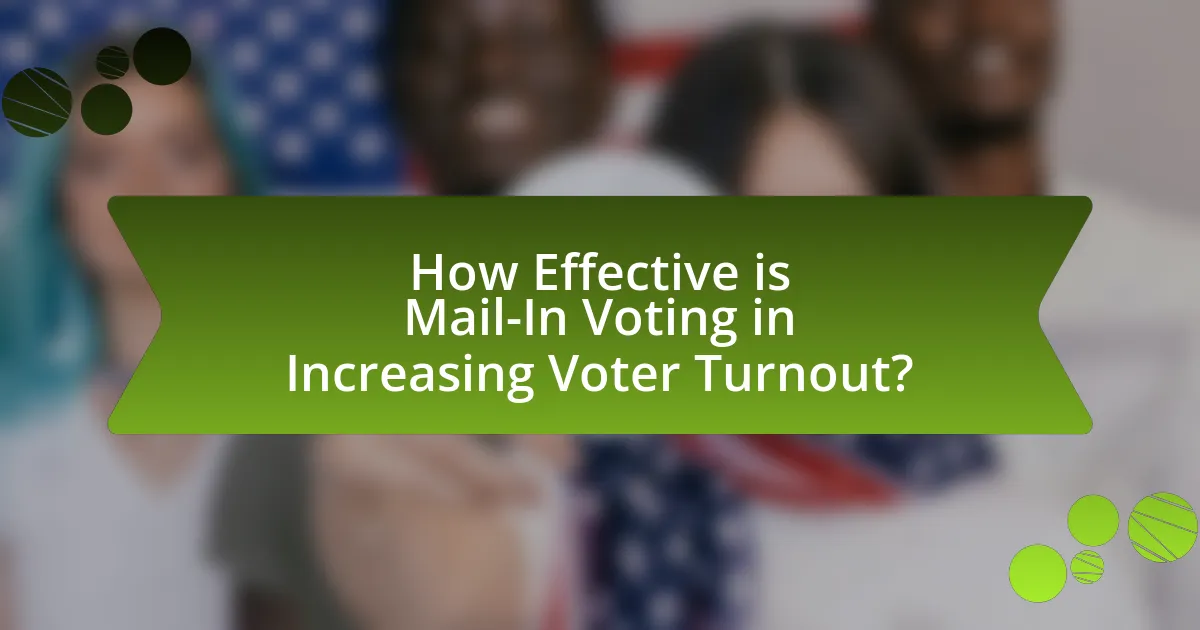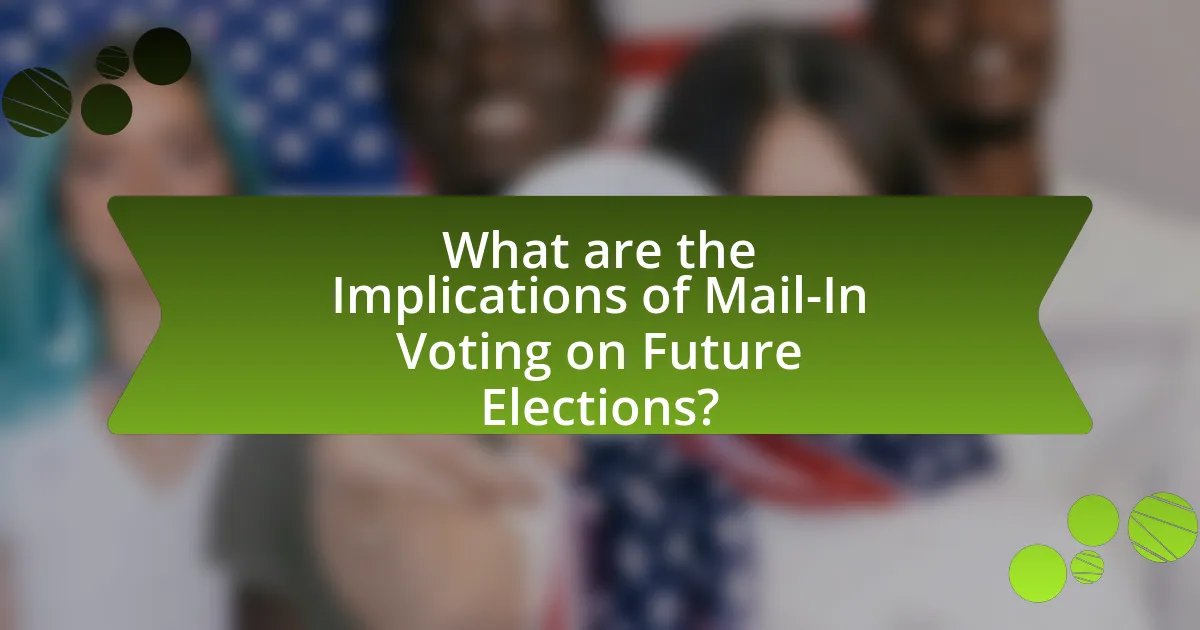Mail-in voting, also known as absentee voting, is a method that allows voters to cast their ballots remotely, enhancing accessibility and convenience. This article evaluates the effectiveness of mail-in voting on voter turnout, highlighting its key features, differences from in-person voting, and the requirements for voters. It discusses the growing popularity of mail-in voting, particularly during the COVID-19 pandemic, and examines factors contributing to its adoption, such as convenience and public health concerns. Additionally, the article analyzes the impact of mail-in voting on voter turnout, challenges associated with the process, and implications for future elections and electoral policies.

What is Mail-In Voting and How Does It Work?
Mail-in voting, also known as absentee voting, is a process that allows voters to cast their ballots remotely rather than attending polling places in person. This method typically involves voters requesting a ballot, receiving it by mail, completing it, and then returning it by mail or designated drop-off locations before the election deadline. According to the U.S. Election Assistance Commission, mail-in voting can increase voter participation by making it more convenient for individuals who may face barriers to in-person voting, such as those with disabilities or those living in remote areas. Studies have shown that states with mail-in voting options often experience higher voter turnout compared to those that do not offer this method.
What are the key features of Mail-In Voting?
Mail-in voting allows voters to cast their ballots remotely, primarily through the postal service, which enhances accessibility and convenience. Key features include the ability to receive and submit ballots by mail, extended time for voters to complete their ballots, and often the option to track the status of their mail-in ballot. According to the U.S. Election Assistance Commission, mail-in voting can lead to increased voter turnout, particularly among those who may face barriers to in-person voting, such as the elderly or disabled. Additionally, studies have shown that states with mail-in voting options tend to experience higher participation rates compared to those without such provisions.
How does the process of Mail-In Voting differ from in-person voting?
Mail-in voting differs from in-person voting primarily in the method of casting a ballot. In mail-in voting, voters receive their ballots by mail, fill them out at their convenience, and return them via mail or designated drop-off locations, allowing for greater flexibility and accessibility. In contrast, in-person voting requires voters to physically go to polling places on Election Day or during early voting periods, which can involve waiting in lines and adhering to specific hours of operation.
Research indicates that mail-in voting can increase voter turnout, particularly among those who may face barriers to in-person voting, such as disabilities or time constraints. For example, a study by the U.S. Vote Foundation found that states with mail-in voting options saw an increase in participation rates compared to those relying solely on in-person voting.
What are the requirements for voters to use Mail-In Voting?
Voters must meet specific requirements to use Mail-In Voting, which typically include being a registered voter in the state where they intend to vote, requesting a mail-in ballot before the deadline, and providing valid identification or personal information as required by state laws. Each state has its own regulations regarding the application process, deadlines, and identification requirements, which can include a driver’s license number, Social Security number, or other forms of ID. For example, according to the National Association of Secretaries of State, 34 states allow voters to request mail-in ballots without an excuse, while others may require a valid reason for absentee voting.
Why has Mail-In Voting gained popularity in recent years?
Mail-in voting has gained popularity in recent years primarily due to increased accessibility and convenience for voters. The COVID-19 pandemic significantly accelerated this trend, as many states expanded mail-in voting options to ensure public safety during elections. According to the U.S. Election Assistance Commission, the percentage of voters using mail-in ballots rose from 23% in the 2016 election to approximately 46% in the 2020 election. This shift reflects a growing recognition of mail-in voting as a viable alternative to in-person voting, particularly for those with health concerns, mobility issues, or scheduling conflicts.
What factors contribute to the increased adoption of Mail-In Voting?
The increased adoption of Mail-In Voting is primarily driven by convenience, accessibility, and public health concerns. Convenience allows voters to cast their ballots from home, eliminating the need to travel to polling places, which is particularly beneficial for those with mobility issues or time constraints. Accessibility is enhanced as Mail-In Voting provides options for individuals who may face challenges in reaching polling locations, such as the elderly or those living in remote areas. Public health concerns, especially highlighted during the COVID-19 pandemic, have prompted many jurisdictions to expand Mail-In Voting to reduce crowding at polling places and minimize the risk of virus transmission. According to the U.S. Election Assistance Commission, the use of Mail-In Voting increased significantly during the 2020 election, with over 50% of voters opting for this method, reflecting these contributing factors.
How do political and social contexts influence Mail-In Voting usage?
Political and social contexts significantly influence Mail-In Voting usage by shaping voter perceptions and accessibility. For instance, during the COVID-19 pandemic, many states expanded mail-in voting options to ensure public safety, leading to a substantial increase in usage; the U.S. Election Assistance Commission reported that mail-in ballots accounted for over 40% of total votes cast in the 2020 election. Additionally, political attitudes towards mail-in voting vary, with some parties advocating for its expansion while others express concerns about potential fraud, impacting voter trust and participation. Social factors, such as community engagement and demographic characteristics, also play a role; research indicates that higher levels of education and community organization correlate with increased mail-in voting rates.

How Effective is Mail-In Voting in Increasing Voter Turnout?
Mail-in voting is highly effective in increasing voter turnout. Studies indicate that mail-in voting can boost participation rates by 2 to 5 percentage points compared to traditional voting methods. For instance, research conducted by the U.S. Vote Foundation found that states with universal mail-in voting saw a significant increase in voter turnout during the 2020 election, with some states reporting turnout rates exceeding 80%. This effectiveness is attributed to the convenience and accessibility that mail-in voting provides, particularly for those who may face barriers to voting in person, such as the elderly or individuals with disabilities.
What evidence exists to support the effectiveness of Mail-In Voting?
Mail-in voting has been shown to effectively increase voter turnout, particularly among specific demographics. Research conducted by the U.S. Election Assistance Commission in 2020 indicated that states with mail-in voting options saw a 5% to 10% increase in participation compared to those without. Additionally, a study published in the American Economic Journal by H. E. Ansolabehere and E. Hersh found that mail-in voting significantly boosts turnout among younger voters and those with mobility issues, demonstrating its role in enhancing accessibility. Furthermore, data from the 2020 presidential election revealed that over 50% of voters utilized mail-in ballots, contributing to the highest voter turnout rate in over a century, which underscores the effectiveness of this voting method in mobilizing the electorate.
How do studies measure the impact of Mail-In Voting on voter turnout?
Studies measure the impact of Mail-In Voting on voter turnout primarily through comparative analysis of turnout rates between mail-in voters and in-person voters. Researchers often utilize data from elections where Mail-In Voting was implemented, comparing voter participation rates before and after its introduction. For instance, a study by the National Bureau of Economic Research found that states that expanded Mail-In Voting saw an increase in voter turnout by approximately 2-5%. Additionally, surveys and statistical models are employed to assess demographic factors and voting behavior, providing insights into how Mail-In Voting influences different voter groups. These methodologies collectively validate the effectiveness of Mail-In Voting in enhancing overall voter participation.
What are the comparative turnout rates between Mail-In Voting and traditional voting methods?
Mail-In Voting generally results in higher turnout rates compared to traditional voting methods. Studies indicate that states with widespread Mail-In Voting can see turnout rates increase by 5 to 10 percentage points compared to states that primarily use in-person voting. For instance, a report from the U.S. Election Assistance Commission found that in the 2020 election, states that offered Mail-In Voting saw an average turnout of 66.7%, while states relying on traditional voting methods had an average turnout of 61.3%. This data demonstrates that Mail-In Voting can effectively enhance voter participation.
What challenges are associated with Mail-In Voting and voter turnout?
Mail-in voting faces several challenges that can negatively impact voter turnout. One significant challenge is the complexity of the mail-in voting process, which can lead to confusion among voters regarding application procedures, deadlines, and ballot submission requirements. Research from the U.S. Election Assistance Commission indicates that states with more complicated mail-in voting systems tend to have lower participation rates. Additionally, issues such as delayed mail delivery, ballot misplacement, and the risk of ballots being rejected due to signature mismatches further hinder voter engagement. A study by the Brennan Center for Justice found that these logistical barriers disproportionately affect marginalized communities, exacerbating existing inequalities in voter turnout.
How do issues like ballot security and voter fraud affect perceptions of Mail-In Voting?
Ballot security and voter fraud significantly influence perceptions of Mail-In Voting by raising concerns about the integrity and reliability of the voting process. Research indicates that when voters perceive a high risk of fraud, their confidence in Mail-In Voting diminishes, leading to lower participation rates. For instance, a study by the Brennan Center for Justice found that states with stricter voter ID laws and heightened security measures often see increased skepticism about Mail-In Voting, despite evidence showing that voter fraud is exceedingly rare, occurring at rates of 0.0003% to 0.0025%. This disconnect between perception and reality can deter eligible voters from utilizing Mail-In Voting options, ultimately impacting overall voter turnout.
What logistical challenges can hinder the effectiveness of Mail-In Voting?
Logistical challenges that can hinder the effectiveness of Mail-In Voting include delays in mail delivery, inadequate staffing at election offices, and insufficient voter education. Delays in mail delivery can result in ballots not arriving on time, which can prevent voters from casting their votes within the required timeframe. According to the United States Postal Service, during peak election periods, mail delivery can be slower than usual, impacting the timely receipt and return of ballots. Inadequate staffing at election offices can lead to processing backlogs, causing further delays in ballot verification and counting. Additionally, insufficient voter education about the mail-in voting process can result in voters not understanding how to properly fill out and return their ballots, leading to higher rates of rejected ballots. These factors collectively undermine the overall effectiveness of Mail-In Voting.

What are the Implications of Mail-In Voting on Future Elections?
Mail-in voting is likely to increase voter turnout in future elections by making the voting process more accessible. Studies indicate that states with mail-in voting options have seen higher participation rates; for instance, a 2020 report from the U.S. Census Bureau showed that states allowing mail-in ballots had an average turnout of 79%, compared to 66% in states without such options. Additionally, mail-in voting can reduce barriers for marginalized groups, including those with disabilities and low-income individuals, further enhancing electoral participation. The implications also include potential shifts in campaign strategies, as candidates may need to engage voters earlier and adapt to the extended voting period that mail-in ballots provide.
How might Mail-In Voting shape electoral policies moving forward?
Mail-in voting is likely to shape electoral policies by promoting broader access to voting and encouraging legislative changes aimed at increasing voter participation. As evidenced by the significant rise in mail-in voting during the 2020 U.S. elections, where approximately 46% of voters utilized this method, policymakers may prioritize reforms that facilitate easier access to mail-in ballots, such as automatic mail-in voting or extended deadlines for ballot submission. This trend suggests that future electoral policies will increasingly focus on reducing barriers to voting, thereby enhancing overall voter turnout and engagement in the democratic process.
What changes could be implemented to enhance Mail-In Voting effectiveness?
To enhance Mail-In Voting effectiveness, implementing a streamlined ballot tracking system is essential. This system would allow voters to track their ballots in real-time, ensuring they are received, processed, and counted. Research indicates that states with ballot tracking systems report higher voter satisfaction and increased turnout; for example, a study by the Brennan Center for Justice found that states with tracking saw a 10% increase in mail-in voting participation. Additionally, improving voter education on the mail-in voting process, including clear instructions and deadlines, can significantly reduce errors and increase confidence in the system.
How do different states approach Mail-In Voting legislation?
Different states approach Mail-In Voting legislation with varying degrees of accessibility and regulation. For instance, California allows any registered voter to request a mail-in ballot, while Texas imposes strict eligibility criteria, permitting mail-in voting only for specific reasons such as age or disability. Additionally, states like New York have recently expanded mail-in voting options, allowing voters to request ballots for all elections, whereas states like Georgia have implemented measures that require voters to provide identification when submitting mail-in ballots. These differences reflect a broader trend where states balance voter accessibility with concerns about election security, impacting overall voter turnout.
What best practices can be adopted to maximize Mail-In Voting effectiveness?
To maximize Mail-In Voting effectiveness, jurisdictions should implement clear communication strategies, ensure timely ballot delivery, and provide accessible voting instructions. Clear communication helps voters understand the process, deadlines, and requirements, which can significantly reduce confusion and errors. Timely ballot delivery is crucial; studies show that ballots mailed well in advance of election day increase the likelihood of voter participation. Additionally, providing accessible instructions, including multiple languages and formats, ensures that all voters, including those with disabilities, can effectively navigate the voting process. These practices are supported by research indicating that jurisdictions employing these strategies see higher voter turnout rates compared to those that do not.
How can voter education improve Mail-In Voting participation?
Voter education can significantly improve Mail-In Voting participation by informing voters about the process, deadlines, and requirements associated with mail-in ballots. When voters are educated on how to properly complete and submit their mail-in ballots, they are more likely to engage in the voting process. For instance, a study by the U.S. Election Assistance Commission found that states with comprehensive voter education programs saw a 10% increase in mail-in voting participation compared to those without such initiatives. This demonstrates that effective voter education directly correlates with higher participation rates in mail-in voting.
What role do technology and innovation play in enhancing Mail-In Voting systems?
Technology and innovation significantly enhance Mail-In Voting systems by improving security, accessibility, and efficiency. For instance, the implementation of secure online ballot tracking systems allows voters to monitor the status of their ballots, reducing anxiety and increasing participation. Additionally, innovations such as automated signature verification and encryption techniques help safeguard against fraud, ensuring the integrity of the voting process. According to a 2020 study by the Brennan Center for Justice, states that adopted advanced voting technologies saw a 10% increase in voter turnout compared to those using traditional methods. These advancements demonstrate that technology and innovation are crucial in making Mail-In Voting more reliable and user-friendly, ultimately encouraging higher voter engagement.



